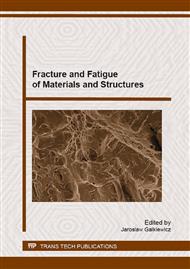[1]
M. Kurek, T. Lagoda, Estimation of fatigue life of materials with out-of-parallel fatigue characteristics under block loading, Fatigue Failure and Fracture Mechanics, Book Series: Materials Science Forum, vol.: 726 (2012), pp.181-188.
DOI: 10.4028/www.scientific.net/msf.726.181
Google Scholar
[2]
M. Kurek, T. Lagoda, D. Katzy, Comparison of Fatigue Characteristics of some Selected Materials, Materials Testing, vol.: 56 (2014), pp.92-95.
DOI: 10.3139/120.110529
Google Scholar
[3]
B. Ligaj, G. Szala, Hybrydowa metoda obliczen trwałosci zmęczeniowej, Wyd. Instytutu Technologii Eksploatacji – Panstwowego Instytutu Badawczego, Radom, (2013).
Google Scholar
[4]
B. Ligaj, Effect of stress ratio on the cumulative value of energy dissipation, Trans Tech Publications, Key Engineering Materials, vol.: 598 (2014), pp.125-132.
DOI: 10.4028/www.scientific.net/kem.598.125
Google Scholar
[5]
A. Lipski, Z. Lis, Improving Fatigue Life of Riveted Joints by Rivet Hole Sizing, Fracture and Fatigue of Materials and Structures, Book series: Key Engineering Materials, vol.: 598 (2014), pp.141-146.
DOI: 10.4028/www.scientific.net/kem.598.141
Google Scholar
[6]
S. Mrozinski, D. Boronski, Metal tests in conditions of controlled strain energy density, Journal of Theoretical and Applied Mechanics, vol.: 45 (2007), pp.773-784.
Google Scholar
[7]
L. Pejkowski, D. Skibicki, J. Sempruch, High-Cycle Fatigue Behavior of Austenitic Steel and Pure Copper under Uniaxial, Proportional and Non-Proportional Loading, Strojniski Vestnik- Journal of Mechanical Engineering, vol.: 60 (2013), pp.549-560.
DOI: 10.5545/sv-jme.2013.1600
Google Scholar
[8]
R. Soltysiak, D. Boronski, Strain analysis at notch root in laser welded samples using material properties of individual weld zones, International Journal of Fatigue 74 (2015), pp.71-80.
DOI: 10.1016/j.ijfatigue.2014.12.004
Google Scholar
[9]
G. Szala, Comments on linear summation hypothesis of fatigue failures, Polish Maritime Research, vol.: 21 (2014), pp.77-85.
DOI: 10.2478/pomr-2014-0033
Google Scholar
[10]
G. Szala, B. Ligaj, Description of cyclic properties of steel in variability conditions of mean values and amplitudes of loading cycles, Fatigue Failure and Fracture Mechanics, Book series: Materials Science Forum, vol.: 726 (2012), pp.69-76.
DOI: 10.4028/www.scientific.net/msf.726.69
Google Scholar
[11]
G. Szala, B. Ligaj, Effect of the exponent in the description of Wöhler fatigue diagram on the results of calculations of fatigue life, Fracture and Fatigue of Materials and Structures, Book series: Key Engineering Materials, vol.: 598 (2014).
DOI: 10.4028/www.scientific.net/kem.598.231
Google Scholar
[12]
J. Szala, Hypotheses of fatigue damage accumulation, (in Polish), Monographs, University of Technology and Agriculture, Bydgoszcz (1998).
Google Scholar
[13]
T. Tomaszewski, J. Sempruch, Verification of the fatigue test method applied with the use of mini specimen, Fracture and Fatigue of Materials and Structures, Book series: Key Engineering Materials, vol.: 598 (2014), pp.243-248.
DOI: 10.4028/www.scientific.net/kem.598.243
Google Scholar


